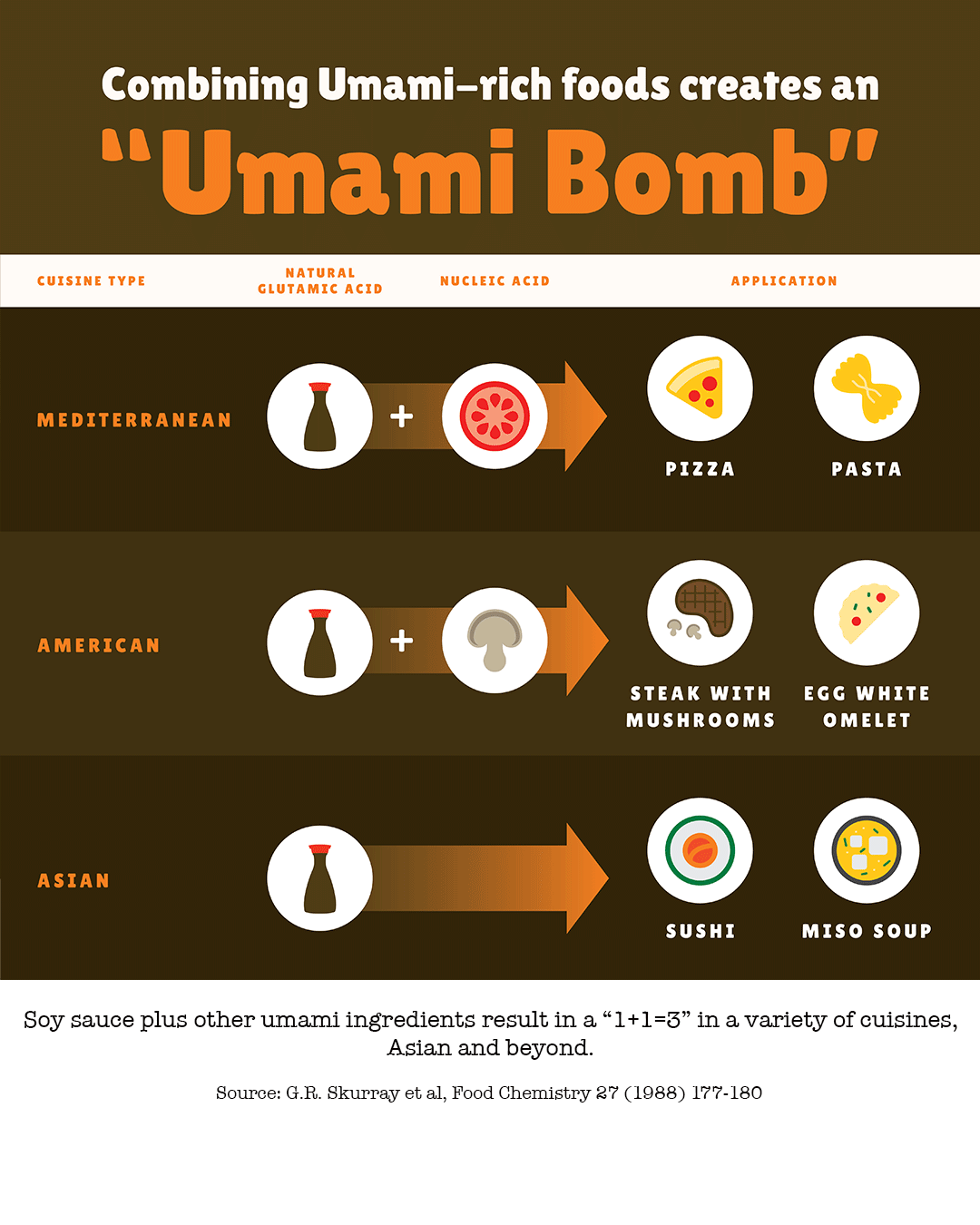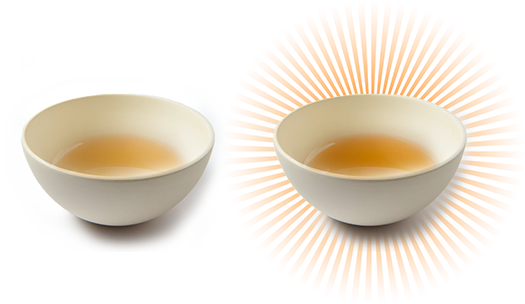Umami Made Easy
How to Harness the Flavor-Enhancing Power of Umami Across Your Menu

Umami Explained
We tend to think of four basic tastes: sweet, sour, bitter, and salty. Umami is the fifth taste—often described as meaty, savory, or brothy. Although it was first identified and analyzed in Japan in the early 20th century, umami has been around for thousands of years as the “secret weapon” of cooks looking to add flavor intensity.
It’s a flavor that is harder to pin down than the other four. But if you know what to look for, umami is instantly recognizable. It’s the tongue-coating richness of reduced meat stock, the intensity of parmesan cheese, the concentrated flavor of sautéed mushrooms or tomato sauce, and the complex, sweet-savory depth of traditionally brewed soy sauce.
What’s behind all of these umami-rich ingredients is a high concentration of certain amino acids, including glutamic acid—often the result of fermentation or reduction. But it’s what they do to other foods that is truly remarkable.
Umami ingredients boost flavor. Add them, and foods taste richer, more intense, and more fully rounded. Traditionally brewed Kikkoman® Soy Sauce is one of the most versatile, all-purpose umami ingredients of all. As I mentioned, cheese, tomatoes, and mushrooms are often cited as examples of umami-rich ingredients. Just look at how brewed soy sauce compares to them in terms of its natural umami.
Soy Sauce & Umami
Kikkoman® Soy Sauce is made from just four natural ingredients: water, soybeans, wheat, and salt. A special aspergillus yeast culture starts the fermentation process that transforms those ingredients into soy sauce over a period of several months, much like the process of making fine wine.
This is essentially how soy sauce has been made since its invention about 2,500 years ago, when it was created as a way to give vegetarian food a richer flavor. In fact, it’s one of the world’s oldest umami ingredients.
But what makes it different from other umami-rich ingredients is its versatility. You’re not going to add a pinch of parmesan cheese or chopped mushrooms to just anything you cook. But traditionally brewed Kikkoman® Soy Sauce, which contains more than 300 distinct flavor and aroma components and is high in total nitrogen content (the measure of a soy sauces’ umami and richness), is an easily incorporated liquid that’s convenient to use and store.
And when used in the right quantity, it can actually act as a natural flavor enhancer for just about anything savory. In other words, soy sauce can be “instant umami”.
The Flavor Threshold
Used in the right proportion, brewed soy sauce can significantly boost the flavor of other ingredients without adding a discernable soy sauce flavor. That’s why it can be used to add depth, flavor balance, and umami to a variety of non-Asian cuisines, including Latin, Mediterranean, and “mainstream American.”
The key to achieving this umami boost is balance. In most cases—especially when working with non-Asian foods—you want the soy sauce flavor to remain in the background, so that you perceive its savory, sweet, meaty qualities without actually identifying a pronounced soy sauce taste. In those applications, including soy sauce at around 2% is a good starting point. Go slowly at first, as you would with salt or pepper, adding soy sauce to taste until you get the proportions right.

Umami Synergy: One Plus One Equals Wow
Soy sauce is particularly useful when you’re preparing a dish that contains other umami-rich ingredients. Add soy sauce to beef, pork, chicken, seafood, mushrooms or tomatoes, for example, and you get what’s called umami synergy. As the flavors combine, they add up to more than the sum of their parts—in other words, you get what many chefs like to call an “umami bomb.”
When making pizza, for example, adding soy sauce to the tomato sauce can create umami synergies with the tomato sauce, the cheese, the pepperoni, and even the yeast in the crust.
8
instant
Umami
Hacks
Umami and Japan
Umami exists in all cuisines, but its name actually comes from Japan. That’s because it was first identified and named in 1908 by Dr. Kikunae Ikeda, a Japanese chemist and professor at the Tokyo Imperial University. Ikeda observed that the same savory, tongue-coating qualities of dashi—the classic Japanese stock, which is made with dried kelp—was also present in cheese, tomatoes, and other foods that have a unique savory flavor that’s distinct from sweet, sour, bitter, and salty. By analyzing the chemical components of kelp, Ikeda discovered that the chemical compound glutamate is responsible for this “fifth taste.”
He called this “new” taste umami, a name he created by combining two Japanese words: umai (delicious) and mi (taste). So, while umami isn’t unique to Japanese food, its name is rooted in Japan—and Japanese cuisine draws on many “super umami” ingredients like soy sauce, mirin, miso, and dashi. No wonder more and more chefs all over the world are now incorporating the “delicious taste” of the sauces, ingredients, and flavors of Japanese cooking into their own culinary creations.
Instant Umami Demo
Want to experience umami firsthand? Try this DIY demo and prepare to be enlightened.


1
Place 1/4 cup warm low-sodium chicken broth or vegetable broth in each of two small bowls. To one bowl, add 1/4 teaspoon Kikkoman® Soy Sauce. This is an inclusion level of about 2% soy sauce.

2
Taste the plain broth.

3
Now taste the Kikkoman-enhanced broth. Notice that you don’t really taste soy sauce, but the broth has more depth and a richer flavor. It’s subtle, yet unmistakable.
Creating Crave
Here’s the bottom line. Umami can make any food more craveable, and in our business, that’s the name of the game. So, check out the umami boosting power of Kikkoman® Soy Sauce, and discover how you can put it to work across your menu.

Want to Learn More?
Listen to my guest appearance on an episode of the podcast CAFÉ Talks devoted entirely to umami.
